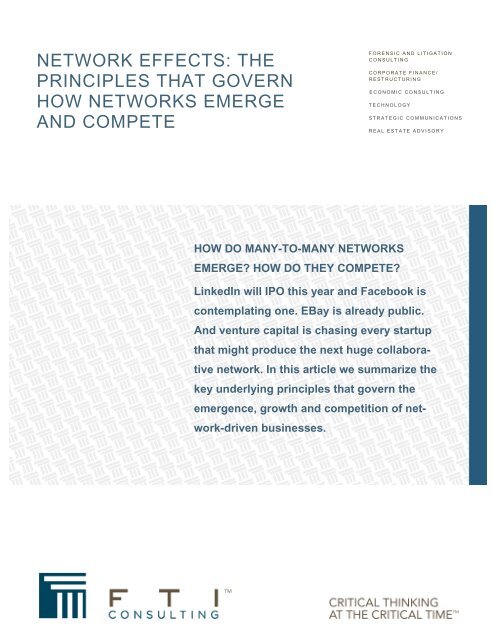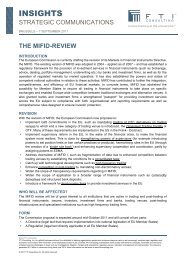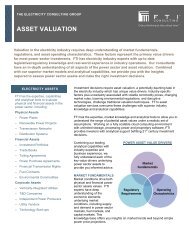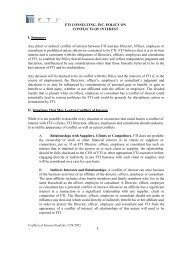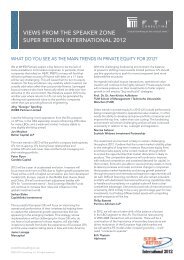Read White Paper - FTI Consulting
Read White Paper - FTI Consulting
Read White Paper - FTI Consulting
Create successful ePaper yourself
Turn your PDF publications into a flip-book with our unique Google optimized e-Paper software.
NETWORK EFFECTS: THE<br />
PRINCIPLES THAT GOVERN<br />
HOW NETWORKS EMERGE<br />
AND COMPETE<br />
FORENSIC AND LITIGATION<br />
CONSULTING<br />
CORPORATE FINANCE/<br />
RESTRUCTURING<br />
ECONOMIC CONSULTING<br />
TECHNOLOGY<br />
STRATEGIC COMMUNICATIONS<br />
REAL ESTATE ADVISORY<br />
HOW DO MANY-TO-MANY NETWORKS<br />
EMERGE HOW DO THEY COMPETE<br />
LinkedIn will IPO this year and Facebook is<br />
contemplating one. EBay is already public.<br />
And venture capital is chasing every startup<br />
that might produce the next huge collaborative<br />
network. In this article we summarize the<br />
key underlying principles that govern the<br />
emergence, growth and competition of network-driven<br />
businesses.
NETWORK EFFECTS<br />
By Bruce Benson, Senior Managing Director, <strong>FTI</strong> <strong>Consulting</strong><br />
Introduction<br />
There are two key types of network structures. The first<br />
type is the “one-to-many” network, like a TV broadcast<br />
network, which broadcasts from the center of the network,<br />
but the individual participants cannot interact. They<br />
second type, which we call “many-to-many” networks, are<br />
ones in which consumers can interact with one another.<br />
Verizon’s cellular network is an example.<br />
The companies that<br />
master these network<br />
effects are the ones<br />
most likely to prosper<br />
disproportionately in<br />
today’s internet economy.<br />
In this paper we describe the key economic rules that<br />
govern the emergence, growth and competitive behavior of many-to-many networks. These networks masquerade<br />
as social networks, exchanges, peer-to-peer sites, telephone networks, chat networks, dating sites,<br />
tweets, wikis, etc. But at the heart of them all is the key element that the network becomes more useful as<br />
more people join. Such networks at scale have extraordinary resistance to competitors because participants<br />
want the largest gathering place possible. As we write this, Facebook now has 700 million members and will<br />
probably reach a billion before the end of 2011. Today it is estimated to be worth over $100 billion dollars.<br />
Several of these networks like LinkedIn are gearing up for their IPO. YouTube was bought by Google for $3<br />
billion, and EBay is the largest auction site in the world. As we write this article, the VC community is scrambling<br />
to fund any startup that exhibits these “network effects”.<br />
On the internet it is easy to create these types of networks. Unlike their physical equivalent, such as a capitalintensive<br />
cell-phone network, these virtual internet networks can be set up in days. Economists have been<br />
studying the behavior of networks for quite some time in a field they call network economics. It is the study of<br />
goods and services whose usefulness is determined, in whole or in part, by the number of other consumers<br />
that use them. They say such goods and services exhibit “network effects” or network externalities. Several<br />
books such as Information Rules 1 were written during the first dot.com that brought the concept of network<br />
economics into the spotlight. However, these books did not anticipate how pervasive these many-to-many<br />
networks would become. The goal of this article is to resuscitate some of these principles, bring in some of the<br />
newer thinking from economists, and describe a few principles of our own. Indeed, it is not too much to suggest<br />
that those companies that master these new network effects are the ones most likely to prosper disproportionately<br />
in today’s internet economy.<br />
The Behavior of Network Goods<br />
A Definition. We will coin the terms network goods or network-dependent goods to mean a product or service<br />
whose usefulness is determined by the size of its network of members. Skype, eBay, faxes, telephones,<br />
and MySpace are network-dependent goods. If their users couldn’t interact, they’d be useless, and the more<br />
members, the more useful they become. Note that all these types of services require a many-to-many network<br />
1<br />
Information Rules by Carl Shapiro and Hal Varian, Harvard Business School Press, 1999<br />
<strong>FTI</strong> CONSULTING | ADVANCED AD OPTIMIZATION RAISES REVENUE AND REDUCES COSTS IN TELEVISION AND RADIO 2
etween their users since they have to interact. This network can be physical, like a phone company’s or virtual<br />
like eBay’s.<br />
The first dot.com era<br />
was about portal networks.<br />
We have entered<br />
the era of the<br />
many-to-many network.<br />
It’s important to stress that just because a service is delivered through a network doesn’t always mean it’s a<br />
network good. Portals like Yahoo! are not network goods. Their usefulness is not dependent on the size of<br />
their network. This is because the users all come and pull information from a central Yahoo! Site; the members<br />
don’t interact. This is true for TV networks as well. They are not network goods because their utility to a viewer<br />
is not a function of how many other viewers there are. In theory, consumers would receive the same broadcast<br />
whether there were 200 or 2 million viewers. These types of networks rely on one-to-many (broadcast)<br />
networks for delivery. In a sense, the first dot.com was about one-to-many “portal” networks. We have now<br />
entered the era of the many-to-many network.<br />
With these preliminaries out of the way, let’s look more closely at the behavior of network goods.<br />
Network size and tipping points<br />
Network goods have an adoption pattern shaped like an S curve. Historically, network goods have taken a<br />
long time to incubate in the market before they hit a tipping point that ignites rapid adoption. This happened<br />
with fax machines. Faxes had a small market niche in filing flight plans of all things, but they only caught on for<br />
general business use when there were a sufficient number of them in the workplace.<br />
Adoption<br />
Tipping Point<br />
Time<br />
Some network goods, of course, don’t survive long enough to reach a tipping point. Video phones are a good<br />
example. Consumers didn’t buy them because none of their friends and family had them, so they were not<br />
very useful. Unable to find a market niche where they could hang on until their penetration grew to spark a<br />
tipping point, they died still-born. The concept was been resurrected anew with Skype Video. However, Skype<br />
first achieved network size in voice calls between computers and only then began offering video -- after their<br />
network of consumers was built.<br />
When two similar services are launched in the market and are network-dependent, a battle ensues to build the<br />
underlying size of their networks. This is because a service’s value to the customer is determined by the very<br />
size of the network it offers. The more members, the more useful it is. When AIM launched in May of 1997 it<br />
wasn’t useful until a sufficient number of people joined. MSN’s Messenger service was launched several<br />
months later. But once AIM’s network reached sufficient size, new customers, facing a choice of which program<br />
to use, naturally opted for AIM because it had the largest network of members. This leads us to our first<br />
principle of network goods:<br />
Principle 1: Consumers are usually compelled to use the service with the biggest network.<br />
We use the word “compelled” in this principle to indicate something far more powerful than the mere size advantage<br />
of the network. The size advantage makes it exponentially more useful and usually dominates the<br />
consumer’s decision-making process. This is because the network with the most members enables more interactivity<br />
which is what the consumers are seeking. In eBay’s case this means more buyers and sellers, in<br />
YouTube’s case it means more amateur video is contributed and shared, and in Skype’s case it means users<br />
can call more people. Indeed, Metcalf’s law regarding these types of networks says that a network of N members<br />
enables N 2 connections.<br />
<strong>FTI</strong> CONSULTING | ADVANCED AD OPTIMIZATION RAISES REVENUE AND REDUCES COSTS IN TELEVISION AND RADIO 3
A tipping point is ignited when the network good hits a critical mass of users and it moves from having niche<br />
utility to mass utility. Because the value of the network increases with its size, a positive feedback loop ensues<br />
-- more people join, it becomes more useful, and even more people join. This leads us to our second<br />
principle:<br />
Principle 2: Being first to market is an even bigger advantage for network goods.<br />
The original service that starts up in a market initially has the bigger size, and Principle 1 says this is where<br />
new members will gravitate. Since the service gets more valuable with size, it follows that the first network will<br />
usually grow faster and reaches a tipping point sooner than later arrivals.<br />
This disproportionate advantage also shows up in the<br />
mathematics. Say AIM initially had 50,000 members versus<br />
MSN’s 10,000. If they each add just one new member,<br />
then AIM will gain 100,000 new connections while MSN<br />
only gains 20,000 2 . The chart at right shows the growth in<br />
connections as both add from one to ten new members.<br />
Of course, consumers don’t do this math, they simply join<br />
the one that is more likely to connect them to the most<br />
people.<br />
We are compelled to warn that being first to market isn’t a guarantee of success or popularity even for network<br />
goods. The features of the service have to be the right ones. (For an excellent elaboration on this subject, see<br />
the book Fast Second by Constantinos Markides and Paul Geroski 3 .)<br />
Network goods and zero-sum games<br />
Networks are often incompatible, meaning that members of one can’t interact with members of another. When<br />
networks are incompatible, the race for consumers is often a zero-sum game, meaning that a gain of a particular<br />
member by one service is a loss to the other. In such cases, when a tipping point is reached, one service<br />
will enjoy a positive tipping point while the other can suffer a negative one.<br />
This has played itself out in the zero-sum competition between MySpace and Facebook. Both were early social<br />
networking sites for teens. However MySpace became very commercialized after being bought by Rupert<br />
Murdock. This turned off consumers – an example of adopting the wrong feature set. Since teens don’t need<br />
two such services, every gain by Facebook has been a loss for MySpace, and its future looks bleak. This<br />
gives us our third principle:<br />
Principle 3: In a zero-sum competition between network goods, the winner takes all.<br />
Facebook was originally smaller than MySpace and should have lost this competition, except that it initially<br />
found safe harbor with the college and high school crowd who wanted to interact privately with other students<br />
but not with the world at large. As MySpace corrupted its original user promise, Facebook became open to<br />
anyone, not just students. Facebook currently has 700 million members and is heading toward one billion.<br />
MySpace is being sold off at the moment for piece-parts.<br />
2<br />
Metcalf’s Law: An interconnected network with N members enables N2 connections. With one additional member, AIM would enable 50,001 2 – 50,000 2 or<br />
100,000 new connections.<br />
3<br />
Josse Boss Press, Copyright Wiley and Songs, 2005.<br />
<strong>FTI</strong> CONSULTING | ADVANCED AD OPTIMIZATION RAISES REVENUE AND REDUCES COSTS IN TELEVISION AND RADIO 4
Not all network goods are zero-sum. Today there are several illegal P2P services for sharing music and<br />
people often use several of them. They are network goods because they depend on their members to share<br />
their music and videos. Yet because not all services have the same content consumers will join several.<br />
Negative tipping points with zero-sum products and services occur with non-network goods as well. Owning an<br />
iPod has become “cool” and the resulting bandwagon effect has made it the product of choice. Since a consumer<br />
doesn’t need two such devices, the MP3 player market is a zero-sum game. Consequently sales of rival<br />
products suffered declines as the iPod exploded in popularity. However, the iPod is not a network good. The<br />
popularity it enjoys can eventually be overcome by rivals who strive to imitate its sleek design and features.<br />
This happened in the ‘80s with the Sony Walkman. In its day, it originally enjoy the same cultish popularity as<br />
iPhones today. Yet, eventually competitors imitated all of the important features, and the Walkman was commoditized.<br />
But in the case of network goods, network size itself is often the dominant and most valued feature.<br />
This is much harder for rivals to overcome -- Network size cannot be imitated in a factory; it must be hard-won<br />
in the marketplace.<br />
Lock-in and Compatibility<br />
This brings us to the issue of consumer lock-in and switching costs. Just as people will join the bigger network,<br />
they will be unwilling to leave the bigger network for a smaller one. The network’s size creates a switching<br />
cost for the consumer, and the consumer is locked in. If Skype has a network with 14 million members and<br />
if Verizon had a similar service with 2 million members, most Skype members would not be tempted to join<br />
Verizon. If some Skype consumers did switch to Verizon, they would lose 12 million connections (14 million –<br />
2 million). This is their switching cost. Hence our fourth principle:<br />
Principle 4: In incompatible networks goods, the bigger the network the greater the lock-in.<br />
Based on the foregoing four principles, it may seem the largest network always wins, and there is nothing the<br />
smaller players can do. Fortunately this isn’t true, and we’ll explore the general subject of network competition<br />
later. However, one key tactic in minimizing the leader’s network size advantage is to become compatible with<br />
their service. Once two services are compatible, consumers are no longer locked in due to network size. For<br />
instance, in the example above, if Verizon and Skye made their services compatible, a Verizon member could<br />
call a Skype member without changing services. They would also gain access to a total of 16 million people,<br />
increasing the utility of both services. This leads to principle five:<br />
Principle 5: The leader’s network size advantage is neutralized and consumer utility is increased when networks<br />
become compatible.<br />
The two services will still compete for market share in terms of quality of service, features, ease of use and<br />
price, but no longer on network size. When do two competitors decide to become compatible and why Again,<br />
we’ll discuss this later in this article.<br />
Only One<br />
It is very interesting to note that many of the network goods we have been discussing completely dominate<br />
their category: Skype for free computer-to-computer phone service, eBay for internet auctions, Facebook for<br />
social networking, YouTube for amateur video and Tweeter for tweets. This gives rise to our sixth principle,<br />
which we have to caution is more of a conjecture, but is supported by our observations:<br />
<strong>FTI</strong> CONSULTING | ADVANCED AD OPTIMIZATION RAISES REVENUE AND REDUCES COSTS IN TELEVISION AND RADIO 5
Principle 6: For most network-dependent services, the market only wants one.<br />
In the case of eBay, the consumer is better off with the largest auction marketplace possible. Sellers are better<br />
off because they can reach a huge number of bidders and they only have to put their items up for bid in one<br />
place. Equally, buyers are better off because they are more likely to find items they’re looking for at the price<br />
they want in a huge market place with lots of sellers. YouTube is similar. People wanting to share their amateur<br />
creations with others find it very convenient to put their videos on one service that reaches millions rather<br />
than several smaller services. Similarly, people wanting to watch amateur video would rather go to one place<br />
where the videos have been viewed and rated by many other people.<br />
In short, consumer utility is maximized when there is a single service. This is very rare in conventional economics.<br />
In conventional economics, competitors slug it out until two or three winners are left standing. Since<br />
consumers want competitors – at least to ensure there is a check on monopolistic pricing and continued innovation<br />
-- there is always room and a need for a second or third supplier.<br />
These dominant services are very hard to dislodge by competitors. Before Google bought YouTube, it tried to<br />
launch its own video sharing site, as did Yahoo and MSN. They got no takers. The market only wanted one.<br />
Competition and Co-opitition in Network Goods<br />
Barry Nalebuff from Yale and Adam Brandenburger from Harvard wrote the book Co-opitition in 1996 4 . Using<br />
results from game theory they brought to light how competitors can often maximize their position through strategic<br />
cooperation with their rivals – a concept they called “co-opitition”. We’ll first discuss competition among<br />
network goods then look at co-opitition in terms of network compatibility.<br />
Competition<br />
In terms of competition between networks, we want to focus on when consumers switch from one network<br />
good or service to another. In conventional economics, competition rages around benefits and price. Obviously,<br />
consumers are looking for the product with the most benefits and least price. In addition, for some goods<br />
and services, there are switching costs that make it harder to switch brands or services. Conventional economics<br />
has boiled all this down to the following relationship:<br />
Consumers switch to a new product when its benefits exceed its price + switching costs<br />
This means that when the perceived benefits of the product or service exceed its price difference against other<br />
alternatives and the consumer’s other hassles of switching, the consumer is susceptible to switching. (This<br />
doesn’t guarantee they will -- humans are extremely inert. In this sense the role of marketing is to overcome<br />
their inertia.) As an example, a consumer may switch to a Mac from a PC when the perceived benefits of a<br />
Mac (such as better graphics, ease of use and slicker design) exceed the additional price of the Mac and the<br />
hassle of switching all of their files from their old PC.<br />
Network economists have added an additional variable to this switching relationship, which is the gain in network<br />
size when switching. So in network economies, consumers switch when:<br />
Benefits + Network Size Gain > Price + Switching Costs 5<br />
In our previous example of Skype vs. Verizon, a person who originally joined Verizon with 2 million members<br />
might soon realize that they’d be better off joining Skype with its 14 million members, a network size gain of 12<br />
4<br />
Published by Currency Doubleday, 1996<br />
5<br />
Derived from Oz Shy’s The Economics of Network Industries, Cambridge University Press, 2001.<br />
<strong>FTI</strong> CONSULTING | ADVANCED AD OPTIMIZATION RAISES REVENUE AND REDUCES COSTS IN TELEVISION AND RADIO 6
million. Since the services are both free, there’s no price issue, and because they are both very intuitive there<br />
are no switching costs. Hence the Verizon members will almost always switch to Skype. Note that if Skpe’s<br />
voice quality was worse (a switching cost) or Skype wasn’t free, then the consumer might forestall switching.<br />
The relationship above is more profound than it may seem. Google is currently trying to figure out how to<br />
launch a site that will steal members away from Facebook. As it does so, the battle with Facebook will be<br />
fought over every variable in this switching equation.<br />
Often on the Web, the price of both the leader’s and the competitor’s service is zero, and switching costs are<br />
minimal, so the battle is all about benefits vs. network size. Since consumers won’t switch from a big network<br />
to a smaller one without a very good reason, the benefits of the smaller competitor’s service will have to be<br />
very significant in order to entice the consumer to switch.<br />
This discussion about competition and switching can be summed up as a single principle:<br />
Principle 7: To switch consumers away from the network size leader, competitors must significantly<br />
exceed the leader in benefits while minimizing price and switching costs.<br />
This principle demonstrates why defeating illegal P2P music networks is so difficult for the music industry. P2P<br />
services are the network size leader in music. The number of illegal downloads per month far exceeds paid<br />
downloads. But legal competitors who want illegal consumers to switch to their service have fewer benefits to<br />
offer because legal services have fewer songs and awkward copy protection schemes. Of course prices are<br />
higher on legal networks because consumer have to pay for their songs. Switching costs are also higher because<br />
the consumer has to re-download their entire library. In short, there is no dimension in the switching<br />
equation above in which the legal network can trump the illegal network. The requirements of Principle 7 cannot<br />
be achieved. Only ramped up legal enforcement (which is a higher “cost” to the pirating consumer) can<br />
force this switch.<br />
The best way for smaller competitors to neutralize the network size advantage of the incumbent is through<br />
compatibility, so let’s now turn to co-opitition.<br />
Co-opitition<br />
When and why does a market leader decide to cooperate with competitors and make their network or product<br />
compatible<br />
The key thing to observe about maintaining network incompatibility is that it’s more expensive for the supplier<br />
than compatibility. There are four main reasons for this:<br />
1. When a service is incompatible it has to develop and maintain its own compliments. For example, in<br />
the case of iTunes it has to maintain its own proprietary song store, its own song format, its own<br />
hardware and software. This is far more expensive than relying on open standards.<br />
2. Incompatibility limits the size of the market for each competitor. The fact that AIM users can’t converse<br />
with Windows Messenger users limits the size of AIM’s network. Today, new users have to<br />
pick the one that lets them chat with the most friends or co-workers (or use both).<br />
3. The marketing costs to explain to consumers the virtues of your incompatible system are higher,<br />
which reduces profits.<br />
4. When services are incompatible, the underdog will undercut the prices of the leader. This forces the<br />
leader to react in kind, driving prices and profits downward. But when services are compatible there<br />
is less competition around pricing. ATM machines are an example. Banks used to have incompatible<br />
ATM networks. Rival banks would cut their fees to attract customers. It eventually became clear<br />
to the banks that fees would be higher and their customers would be happier if they made their net-<br />
<strong>FTI</strong> CONSULTING | ADVANCED AD OPTIMIZATION RAISES REVENUE AND REDUCES COSTS IN TELEVISION AND RADIO 7
works compatible and so they did.<br />
Since the cost of incompatibility is high, profits are lower for all competitors than they might be under compatibility.<br />
Consequently there often comes a point in the market leader’s progression when they have gained as<br />
much market share as possible under incompatibility and will shift to compatibility. In doing so, they pick up<br />
probably more than their fair share of the fence-sitting customers while lowering costs and improving profits.<br />
In addition, the leader can often create this compatibility by licensing access their dominant technology or<br />
network access to others, and thereby also gain new revenue from their competitors. This gives us an eighth<br />
principle:<br />
Principle 8: Since compatibility is more profitable, the market leader will usually shift to compatibility<br />
after capturing his market share under incompatibility.<br />
The Logic of Compliments<br />
When content is distributed on a many-to-many network, the network and the content shared on it are compliments.<br />
They are both required to deliver the service to the consumer, and the service cannot exist without<br />
both. While co-dependent, the network distributor and the content provider are rarely equal. A large distributor<br />
like Apple has significant pricing leverage over content owners, but with smaller distributors the content owner<br />
has pricing power.<br />
One important way to gain a price advantage when the players are complimentary is to commoditize your<br />
partners by finding several suppliers of the needed compliment. This is easy to see in the case of Yahoo<br />
News, who can commoditize its national news suppliers by making deals with Reuters, AP and even have its<br />
own journalists. This creates price competition among Yahoo’s news suppliers and weakens the suppliers’<br />
pricing leverage. Equally, content owners will seek many distribution partners so that no one of them has<br />
much power over the content owner. This gives us our ninth principle:<br />
Principle 9: Complimentary partners in a network will attempt to commoditize each other.<br />
A special case arises when there is only one source of content or only one significant distribution partner.<br />
Owners of unique content like a hit movie know its distribution partners can’t get it anywhere else and so they<br />
can’t be commoditized. This leads to their favorite axiom that content is king. But this is really only true when<br />
there are multiple distribution outlets. When there’s only one major distributor, content isn’t king. In the case of<br />
iTunes, who owns 90% of the digital music download market, iTunes has set a uniform and low price for all<br />
songs of 99 cents. They have virtually commoditized the music labels’ content. Consequently when content<br />
owners with desirable content come up against a dominant distributor, things can get fractious.<br />
This leads to our last principle:<br />
Principle 10: Complimentary networks exist only when the participants’ revenue models are aligned.<br />
This is not quite as obvious as it sounds. Of course, the participants in a delivery network won’t do business<br />
with each other if they can’t make money, but it’s how they each make their money that makes the partnership<br />
possible. For example, MTV distributes its content nationally through various cable companies. The two parties<br />
have found alignment: the cable companies make money through subscription fees to the consumer, while<br />
MTV makes money through advertising within the content. (MTV also get some licensing fees from the cable<br />
operator.) This is not the case with YouTube. Both the content owners and YouTube’s parent, Google, want<br />
to make money from advertising in the content. To date, they can’t agree on a revenue sharing arrangement<br />
or who owns the customer relationship. Their business models are out of alignment.<br />
<strong>FTI</strong> CONSULTING | ADVANCED AD OPTIMIZATION RAISES REVENUE AND REDUCES COSTS IN TELEVISION AND RADIO 8
Conclusion<br />
While we have exposed the key principles of network competition, knowing these principles is not in itself a<br />
competitive strategy. Conventional consumer companies must understand how they will compete with these<br />
networks. Content owners must decide how they will negotiate, how they will create leverage for themselves,<br />
and how they will co-exist. Startups and VCs must understand how they will get to market quickly, create the<br />
winning features for their members, and how they will hit a tipping point before other market entrants do. And<br />
existing network competitors like Facebook and Google must understand how they will win share away from<br />
one another by using the principles above to their best advantage.<br />
We believe we have entered the era of the network economy. This really can’t be in doubt as we watch Facebook<br />
help topple Eastern governments. Companies have to build their strategies from these principles. Failing<br />
to do so can be disastrous. Rupert Murdock paid $250 million for MySpace, but he failed to preserve the benefits<br />
consumers wanted in a social network (Principle 7) and MySpace is all but forgotten.<br />
If you’re concerned about your company’s strategy in a networked world, give us a call, <strong>FTI</strong> is here to help.<br />
<strong>Read</strong>ers should feel free to contact us at:<br />
Bruce Benson<br />
Senior Managing Director<br />
Entertainment, Media & Digital<br />
203.606.3854<br />
Bruce.benson@fticonsulting.com<br />
<strong>FTI</strong> <strong>Consulting</strong><br />
3 Times Square, 11 th floor<br />
New York, NY 10036<br />
<strong>FTI</strong> CONSULTING | ADVANCED AD OPTIMIZATION RAISES REVENUE AND REDUCES COSTS IN TELEVISION AND RADIO 9
CONTACT:<br />
Dave Garland<br />
Managing Director, Media and Entertainment<br />
<strong>FTI</strong> <strong>Consulting</strong><br />
212.651.7144 (office)<br />
David.Garland@fticonsulting.com<br />
www.fticonsulting.com<br />
Bruce Benson<br />
Senior Managing Director, Media and Entertainment<br />
<strong>FTI</strong> <strong>Consulting</strong><br />
646.453.1289 (office)<br />
Bruce.Benson@fticonsulting.com<br />
www.fticonsulting.com<br />
About <strong>FTI</strong> <strong>Consulting</strong><br />
<strong>FTI</strong> <strong>Consulting</strong>, Inc. is a global business advisory firm dedicated to helping organizations protect and enhance enterprise value in an increasingly complex legal, regulatory and economic<br />
environment. With more than 3,700 employees located in 26 countries, <strong>FTI</strong> <strong>Consulting</strong> professionals work closely with clients to anticipate, illuminate and overcome complex business<br />
challenges in areas such as investigations, litigation, mergers and acquisitions, regulatory issues, reputation management and restructuring. The company generated $1.5 billion in<br />
revenues during fiscal year 2010.<br />
fticonsulting.com<br />
© <strong>FTI</strong> <strong>Consulting</strong>, Inc., 2010. All rights reserved.<br />
<strong>FTI</strong> CONSULTING | ADVANCED AD OPTIMIZATION RAISES REVENUE AND REDUCES COSTS IN TELEVISION AND RADIO 10


